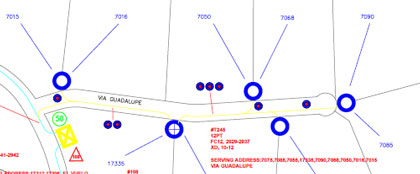
Terminals
A terminal is a fiber end point that ends with connectors. Instead of using fusion splicing to extend the fiber network to a house drop, you use a drop cable that has a field connector on one end that plugs into the terminal. This makes it easier to add new houses after the initial backbone network is constructed - no fusion splicing is needed.
Shown here is an example of such a terminal.
All terminals must have some way of protecting their connectors from water intrusion. In this case, these are special "Optitap" connectors (an open source industry standard) that can screw onto the terminal's external connectors forming a water tight connection.
All terminals will have a "tail" which is multi fiber cable that will run back through conduit to the nearest splice closure for fusion splicing to the backbone cable.
You might use such an 8 port or 12 port terminal in a design like this one where a terminal is in an underground vault and serves several distributed houses (the circle with the X is where such a terminal would go to serve the other locations via buried flower pots):

You can also extend your terminals all the way to the property edge if you use many 2 port terminals like this one shown here:

In this design, you would leave such a 2-port terminal in a small "flower pot" at grade level to serve two houses.
If you use terminals, you must make sure that the connections are waterproofed, just as you do for splices.
